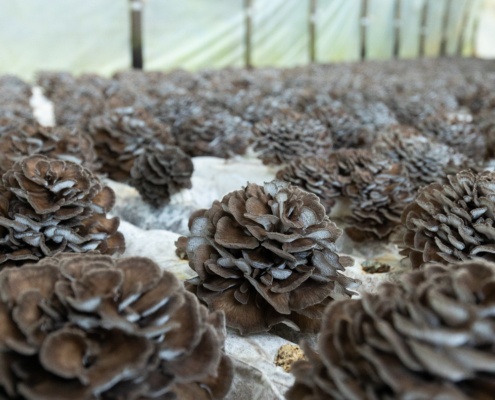MycoD2™
Grifola frondosa
Nammex maitake mushroom is processed by hot water extraction and then undergoes high pulse UV light exposure to convert ergosterol to Vitamin D2 (ergocalciferol).
| Vitamin D2 (ergocalciferol) | Greater than 10,000 IU per gram |
Natural Vitamin D from Mushrooms
No added fillers, starch, grains or mycelium
It is a well known fact that mushrooms contain relatively low levels of vitamin D. For example, the common button mushroom has approximately 7IUs and shiitake has 154IUs of vitamin D2 per 100 grams of fresh mushrooms.
D2 levels in mushrooms can be measured through HPLC testing and by following existing scientific research, Nammex has developed a process to amplify the D2 concentration in mushrooms by exposure to UV light. Both Vitamin D2 and D3 are formed by the conversion of precursor compounds: ergosterol for D2, and 7-dehydrocholesterol for D3. Ergosterol, which is a fungal sterol similar to cholesterol in humans, is converted into ergocalciferol (D2), in the same manner cholesterol is converted to cholecalciferol in human skin. Since 2015, Nammex has been measuring ergosterol as a primary quality marker of its functional mushrooms and has identified species with high amounts.
Nammex’s new MycoD2™ offers 10,000 IU/g of Vitamin D2 in the matrix of an organic 1:1 Maitake (Grifola frondosa) mushroom powdered extract and achieved this breakthrough using natural growing techniques and pulsed UV light exposure, ultimately letting the mushroom itself produce these high levels of vitamin D.
Vitamin D Sources
Most vitamin D is sold in its D3 form, and it’s primarily made by irradiating cholesterol extracted from sheep lanolin, a process that uses large amounts of harmful chemicals. This may seem unattractive to some who do not consume or use animal products. The available non-animal forms (yeast, mushrooms) are actually based on the fungal kingdom and are primarily D2 (1). There is lichen-based D3 which is derived from an edible lichen (a complex life form made from a fungus and alga).
Cultivation
Specially selected natural materials such as protein enriched sawdust and hardwood logs are used as the nutrient base for Nammex mushroom cultivars. These natural substrates contain precursors that guarantee the production of important medicinal compounds. The Maitake Mushroom crops are produced in shaded greenhouses with a constant flow of fresh air and fresh water from deep wells. Natural sunlight provides the stimulus for proper mushroom formation.
D2 vs D3
There has been some debate on whether vitamin D3 is more effective than D2 (2). The two forms have traditionally been regarded as equivalent based on their ability to cure rickets (a skeletal disorder that is caused by a lack of vitamin D, calcium, or phosphate). Most steps involved in the metabolism and actions of vitamin D2 and vitamin D3 are identical. Both forms can raise serum 25(OH)D levels (3).
Vitamin D expert, medical doctor, author, and researcher Dr. Michael Hollick, uses a synthetic Vitamin D2 form in his clinic and his data suggests it is as efficient as Vitamin D3 (2). He did mention that you have to get a good quality source and dose.
While some older research publications suggested that D2 intake may decrease the construction of Vitamin D3 (4), Dr. Hollick maintains that these studies dismantle the future use of Vitamin D2 for therapeutic purposes without substantiated evidence. He has conducted his own Vitamin D research, performing 3 studies on Vitamin D2 and Vitamin D status. He confirmed that the kidneys are able to convert Vitamin D2 to the active form of Vitamin D (2).
MycoD2™ is a wholefood mushroom source of vitamin D using a proprietary pulsed UV light method that has enabled Nammex to achieve consistently high levels of this important vitamin. D2’s role as an antioxidant with multiple applications for human health is well recognized and MycoD2™ from Nammex now offers this in a certified organic standardized whole Mushroom Powder.
Proudly Made in China
In 1996, CEO and Founder of Nammex, Jeff Chilton organized organic mushroom production in China. That initiative paid off and today all Nammex mushrooms are grown deep or wildcrafted in the mountains of China by our Certified Organic production partners.
Not All Medicinal Mushrooms Products are Created Equal
US lab-grown Oyster is mycelium grown on grain. Analysis has shown that US Oyster mycelium on grain has low levels of beta-glucan and very high levels of starch. Nammex only uses 100% organic fruiting bodies which are rigorously tested and guaranteed for active compounds. Learn more about the mycelia myth and the 10 Questions to Ask about Your Mushroom Supplement.
Active Compounds
Vitamin D2; Beta (1>3),(1>6)-glucans
Product Attributes
Certified Organic; Kosher; Vegan; Gluten-free; Non-GMO
Research and References
- Cardwell, G., Bornman, J. F., James, A. P., & Black, L. J. (2018). A Review of Mushrooms as a Potential Source of Dietary Vitamin D. Nutrients, 10(10), 1498. https://doi.org/10.3390/nu10101498
- Holick, M. F., Biancuzzo, R. M., Chen, T. C., Klein, E. K., Young, A., Bibuld, D., Reitz, R., Salameh, W., Ameri, A., & Tannenbaum, A. D. (2008). Vitamin D2 is as effective as vitamin D3 in maintaining circulating concentrations of 25-hydroxyvitamin D. The Journal of clinical endocrinology and metabolism, 93(3), 677–681. https://doi.org/10.1210/jc.2007-2308
- https://ods.od.nih.gov/factsheets/VitaminD-HealthProfessional/
- Trang, H. M., Cole, D. E., Rubin, L. A., Pierratos, A., Siu, S., & Vieth, R. (1998). Evidence that vitamin D3 increases serum 25-hydroxyvitamin D more efficiently than does vitamin D2. The American journal of clinical nutrition, 68(4), 854–858. https://doi.org/10.1093/ajcn/68.4.854

